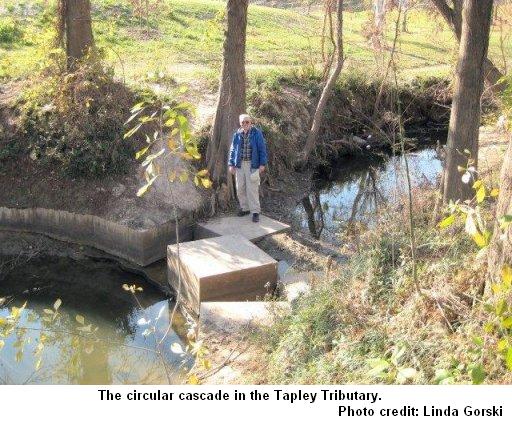
The
north bank of Buffalo Bayou near Sawyer Street is separated, and
somewhat isolated, from the Sixth Ward neighborhood by Memorial Drive.
As a result, this part of Buffalo Bayou Park is a pleasant green space
that receives much less use than the companion park land on the south
bank of the bayou. The hiking trail coming from the Waugh Drive area
passes under Memorial Drive and emerges in the grassy meadow where the
unique art structure entitled "Passage Inacheve" stands. Heading east
from the "Passage Inacheve," the hiking trail crosses a rustic
footbridge over a small stream that has been named in honor of Charles
Tapley.
In the late 1970's, Charles Tapley, a local landscape architect,
designed an innovative site along the north bank of Buffalo Bayou west
of Sabine Street that included a tributary with riparian plantings and
seating areas with attractive granite steps. However, after a quarter
of a century of neglect, Tapley's initiative was in dire need of
revitalization. In 2004, the Buffalo Bayou Partnership sponsored a
project to restore Tapley's site to its original vision.
Tapley's design included several resting places along the hiking trail
and on the upper slopes of the bayou's bank that entice the visitor to
sit and view the beauty of the bayou. The simple, yet elegant, granite
benches are placed within view of the bayou and the tributary. High on
the slope near the new Lee and Joe Jamail Skatepark is the largest of
Tapley's seating stones. The triangular granite benches form a shady
circle amidst the small cluster of trees. This set of granite stones is
the largest seating area of the tributary site. Other stones that
provide rest stops for an individual or couple are located at places
near the creek and along the trail.

Within the tributary, Tapley created rapids
and cascades to tumble the water as it flows from the wetland pond to
its confluence with the bayou. Directly below the bridge over the
stream, a set of granite blocks creates a small rapid where the water
bubbles over the blocks and channels while flowing under the canopy of
cypress tress. A few yards later, the stream flows over the circular
cascade of large granite stones that open into a block-lined pool.
Along the course of the tributary, there are individual granite seating
stones in the form of square blocks.

The goal of the restoration of the Tapley Tributary was to
demonstrate the benefits of wetland habitat within the urban
environment. Undesirable and invasive plants were removed from the
drainage, and wetland plants, such as cattails and lilies, that improve
water quality were planted in the tributary. Since the Tapley Tributary
is the storm water outfall from White Street and the Sixth Ward
neighborhood, the wetland plants which have root structures that can
remove minerals, heavy metals and toxins from the water, help to
improve the urban runoff that flows into Buffalo Bayou. River birch and
cypress trees were added to the 150 yard long stream to help stabilize
the banks and provide an attractive bayou woodland. The enhancements
and management practices used in the restoration of Tapley Tributary
will be applied to other sites along the bayou.

And in case you think Charles Tapley’s resume is limited to
Buffalo Bayou, you’d be wrong. Tapley actually opened his
architectural practice in 1960 and has designed parks, churches and
other buildings around the country. In addition to his master
plan for Buffalo Bayou which called for natural wide banks instead of a
“concrete slip and slide”draining to the Houston Ship
Channel, Tapley also designed Tranquility Park in downtown Houston.
Tapley also helped found the Lynn R. Lowrey Arboretum at Rice
University and is currently on the architecture faculty at the
University of Houston.
Take time to stop in the Tapley Tributary park space. The natural
beauty and peacefulness of this bayou tributary with the backdrop of
our great city is a rare treat and a grand tribute to Charles Tapley's
vision.